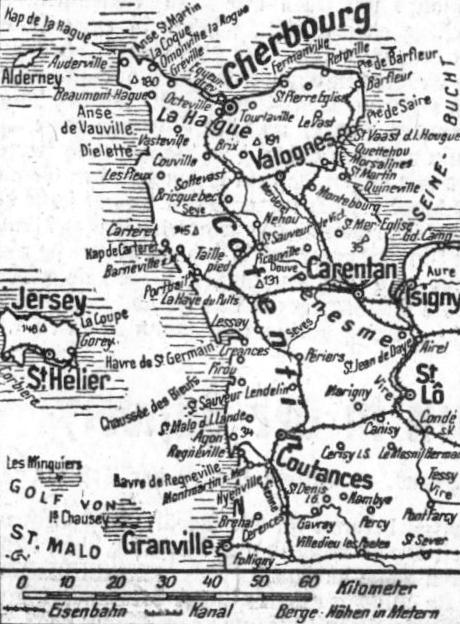The Free Lance-Star (June 16, 1944)
Nazi resistance grows in violence
By Wes Gallagher
Allied array in Normandy

Here is the disposition of Allied divisions thus far officially disclosed to be participating in the battle of the Normandy beachhead (black line). Six U.S. Army divisions have been officially reported in action in the areas indicated by the pointers in the western sector, and two British and one Canadian division in the eastern sector.
SHAEF, London, England (AP) –
Lt. Gen. Bradley’s troops, ramming home another blow to cut off Cherbourg, have advanced to within two and a half miles east of Saint-Sauveur, a junction controlling two of the three roads leading to the nearly beleaguered port, Allied headquarters announced today.
The Americans marked up a gain of two and a half to three miles west of Carentan after having previously reached Regnéville, three miles to the northeast of Saint-Sauveur.
Plugging away on a 10-mile front and rapping out repeated gains despite stubborn resistance, the Americans were now within 11 miles of the Cherbourg Peninsula’s west coast beaches. Their spearhead was some 17 miles below the big port.
While Bradley’s Yanks still fought a dingdong battle with Germans in the streets of Montebourg, 14 miles southeast of Cherbourg on the allied right flank, the British were engaged in stiff tank battles with German troops in force two miles south of Caumont. This is about 20 miles inland, the deepest Allied penetration.
Tank battles also still raged around Caen and Tilly-sur-Seulles on the Allied left flank.
Weather turns bad
Meanwhile, headquarters reported the worst weather over the battlefields since D-Day with a 20-mile-an-hour northwest wind blowing onto the beaches – the only place the Allies now hold for the reinforcement and supply of their invasion armies.
Despite the weather, however, the battleships USS Texas and USS Nevada and the cruiser USS Augusta were reported arching their shells deep inland in support of the troops driving across the peninsula.
A few miles south of the U.S. spearhead pointed at Saint-Sauveur was another column pushing toward Le Haye-du-Puits, a road junction controlling all the remaining roads leading into Cherbourg. The Americans were last reported about six miles from this objective.
A late dispatch from Gen. Dwight D. Eisenhower’s advanced command post said it was estimated 300,000 German troops had been thrown against the Normandy beachhead.
This dispatch said four German divisions had been badly mauled in battle, including the 709th, 711th and 352nd.
Reserves sent in
Alive to the vital necessity of holding Saint-Sauveur and Le Haye-du-Puits, the Germans rushed reserves into the battle and vigorous, fluid fighting was in progress.
The German communiqué said the Nazis drove the Allied back southeast and southwest of Carentan, but admitted Allied gains west and north of Sainte-Mère-Église. It also claimed that a wedge had been driven into the allied bridgehead east of the Orne River.
West of newly-captured Quinéville, on the extreme right wing of the 100-mile beachhead front, U.S. forces advanced a mile or more to reach the Sinope River.
These were the only advances registered along the front. Communiqué No. 21 said there were no major changes.
Furious armored fighting raged in the Tilly-sur-Seulles sector, while further east, the battle of Caen settled into trench warfare with the British and Canadians holding on tenaciously. The nearest approach to a “line” was held around Troarn, at the extreme left flank of the bridgehead.
Generals up front
Field dispatches said mobile fighting in the spearheads of the American sector found generals in the frontline with their troops, tossing hand grenades and firing rifles side by side with privates.
U.S. columns pushing forward sometimes were cut off and had to fight their way back into contact with the main forces.
Weather hampered air operations somewhat, but unloading of troops and supplies on the beachhead continued at full blast, and Supreme Headquarters declared Montgomery’s striking power “is growing daily.”
Photographs of Le Havre after a raid by RAF Lancasters Wednesday night showed the German E-boats, which had been lurking there to attack the flanks of the ceaseless trans-Channel convoys, had disappeared. Before the raid, 10 E-boats and motor torpedo boats had been seen in the harbor.

